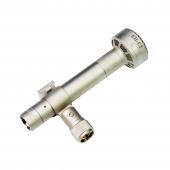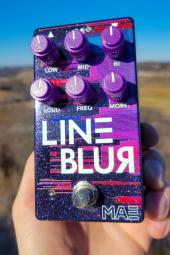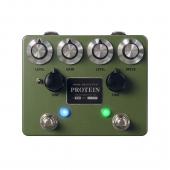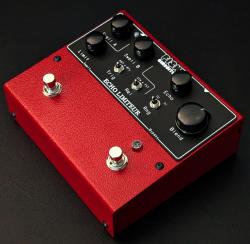Fish Circuits Echo Limiteur
Brands:
The Fish Circuits ECHO LIMITEUR is a hybrid analog and digital delay with up to 1750ms of delay time and a limiter circuit on one of the two switchable feedback settings. The delay range of the MN3005 analog delay chip has been stretched as far as possible, just before becoming unstable, allowing for lo-fi or degraded repeats on longer delay times. And for the sake of versatility, this range can be extended in the case that higher-fi repeats are preferred. Not hi-fi, mind you, more like a cross between a tape echo, an analog delay, and a low battery radio.
The limiter function is probably the most uncommon element of this pedal. We probably should have started with that, it’s in the name after all. The limiter dynamically reduces the feedback of the delay and can be triggered by the dry or wet signal, or both. This allows to have infinite repeats that can self-regulate not to overpower your dry sound, and/or infinite repeats that reset with every picked note or chord, and/or simply two different loudness for said repeats. That, and users will without a doubt find many other ways to creatively use this feature.
In true Fish Circuits tradition, which is a young tradition but a tradition nonetheless, we’ve used unfamiliar, cryptic, or vague labels for each control. Here’s what they mean :
“Swell A” and “Swell B” are the two switchable feedback controls both ranging from a single repeat to an infinite distorted mess. Switch between the two controls with the left footswitch, aptly labeled “Swell”, and a corresponding indicator will light up. The green indicator means Swell A is activated while the red indicator means Swell B is. Only Swell B is affected by the limiter and when activated, its indicator will turn red-green-ish as the limiter gets triggered. Use this visual cue to adjust the “Limit”, “Trig”, and “Rel” to your liking.
“Limit” is simultaneously the sensitivity of what triggers the limiter and the aggressivity of the limiter itself. From left to right, less sensitive and less aggressive to very sensitive and very aggressive. Meaning that the more sensitive the trigger is, the more aggressive the limiter is at reducing the feedback volume of the delay, cutting short what will most likely be an infinite feedback. What activates the limiter and how it behaves is controlled by the “Trig” and “Rel” switches.
“Trig” lets you select what triggers the limiter. “Wet” means that the limiter is only triggered by the delayed repeats, while “dry” means that it is only triggered by, you’ve guessed it, the dry signal. In the middle position, represented by the white dot, both wet and dry signals trigger the limiter. The setting you choose on this toggle will dictate how the limiter reacts and is probably where one should start when messing with the limiter feature.
“Rel” means release, which simply controls how quickly the limiter should stop limiting. “Slw” means slow, “fst” means fast, and the white dot is the midpoint. As a rule of thumb, if the limiter doesn’t seem to do anything even if the indicator light comes on, try a slower release. If on the other hand the limiter limits too much, and/or for too long, try a faster setting. “Rel” and “Limit” are influenced by one another and control how the limiter feels. For example, a more sensitive limit means longer release times, and vice versa.
“Echo” is the delay time, from short to long. This pot’s range is affected by the “Rng” toggle, however the lo-fi-ish repeats will start to appear in the last quarter or so of the range of the pot independently of the position of the toggle. This means that for most of the range, a clean repeat should be expected, whether the toggle is in the “lo” or “hi” range. (by clean repeat we mean as clean as what analog delays are known for, so not that clean)
“Rng” basically kicks in, or out, the PT2399. On “lo”, meaning low range, the delay times controlled by the “Echo” pot will have a range from “pretty damn quick” to “about 650ms”. This setting allows to have lo-fi repeats earlier, or to have tighter control on short delay times, or both. On “hi”, meaning high range, the maximum delay is extended by roughly 1100ms, for a total of up to 1750ms. This allows for cleaner repeats on a wide range of delay times while still having a lo-fi element towards the rightmost end of the spectrum.
“Blend”, get this, serves to control how much of the delayed repeats are mixed in, or blended in, with the clean signal. No delay comes through when it’s down to 0, and repeats will be louder than the clean signal at its maximum. There is only one “Blend” control, but depending on how you are using the limiter, you could effectively have a different output volume for the repeats when “Swell B” is on.
___________________
Dimensions : 6” x 5.25” x 2.5”
Weight : 2.3lbs
Power : 9V DC, negative tip, 2.1mm barrel power supply
Current draw : 60mA












